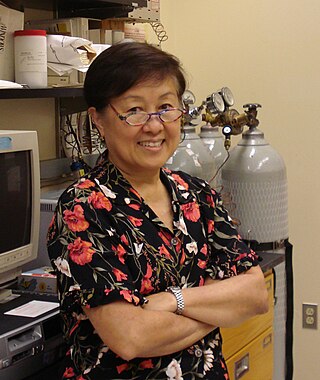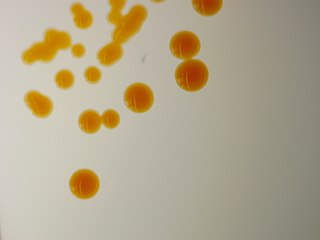Related Research Articles

Sphingomonas was defined in 1990 as a group of Gram-negative, rod-shaped, chemoheterotrophic, strictly aerobic bacteria. They possess ubiquinone 10 as their major respiratory quinone, contain glycosphingolipids (GSLs), specifically ceramide, instead of lipopolysaccharide (LPS) in their cell envelopes, and typically produce yellow-pigmented colonies. The GSL serves to protect the bacteria from antibacterial substances. Unlike most Gram-negative bacteria, Sphingomonas cannot carry endotoxins due to the lack of lipopolysaccharides, and has a hydrophobic surface characterized by the short nature of the GSL's carbohydrate portion.

Sphingomonadaceae are a gram-negative bacterial family of the Alphaproteobacteria. An important feature is the presence of sphingolipids in the outer membrane of the cell wall. The cells are ovoid or rod-shaped. Others are also pleomorphic, i.e. the cells change the shape over time. Some species from Sphingomonadaceae family are dominant components of biofilms.
Cometabolism is defined as the simultaneous degradation of two compounds, in which the degradation of the second compound depends on the presence of the first compound. This is in contrast to simultaneous catabolism, where each substrate is catabolized concomitantly by different enzymes. Cometabolism occurs when an enzyme produced by an organism to catalyze the degradation of its growth-substrate to derive energy and carbon from it is also capable of degrading additional compounds. The fortuitous degradation of these additional compounds does not support the growth of the bacteria, and some of these compounds can even be toxic in certain concentrations to the bacteria.

Rhodococcus is a genus of aerobic, nonsporulating, nonmotile Gram-positive bacteria closely related to Mycobacterium and Corynebacterium. While a few species are pathogenic, most are benign, and have been found to thrive in a broad range of environments, including soil, water, and eukaryotic cells. Some species have large genomes, including the 9.7 megabasepair genome of Rhodococcus sp. RHA1.
Mycobacterium vanbaalenii is a rapidly growing mycobacterium that can use polycyclic aromatic hydrocarbons. It was first isolated from petroleum-contaminated estuarine sediments and has been shown by 16S rRNA gene sequencing to be closely related to Mycobacterium aurum and Mycobacterium vaccae. M. vanbaalenii has potential use in the bioremediation of polycyclic aromatic hydrocarbon contaminated environmental sites. Etymology: vanbaalenii of Van Baalen, in memory of Dr Chase Van Baalen, late Professor at The University of Texas Marine Science Institute, Port Aransas Marine Laboratory, Port Aransas, TX, USA.
Novosphingobium is a genus of Gram-negative bacteria that includes N. taihuense, which can degrade aromatic compounds such as phenol, aniline, nitrobenzene and phenanthrene. The species N. aromativorans, which was first found in Ulsan Bay, similarly degrades aromatic molecules of two to five rings.

Lily Young is a distinguished professor of environmental microbiology at Rutgers New Brunswick. She is also a member of the administrative council at Rutgers University. She is the provost of Rutgers New Brunswick. She is a member of the Biotechnology Center for Agriculture and the Environment and has her academic appointment in the Department of Environmental Sciences.
Delftia lacustris is a Gram-negative, nonfermentative, motile, rod-shaped bacterium from the family Comamonadaceae, which was isolated from mesotrophic lake water in Denmark. It has the ability to degrade peptidoglycan through chitinase and lysozyme activity.
Cycloclasticus pugetii is a species of bacterium found in marine sediments. It is notable for being able to break down aromatic hydrocarbon, including naphthalene, phenanthrene, anthracene and toluene. It is an aerobic, gram-negative, rod-shaped bacterium from the family Piscirickettsiaceae, and it is motile by means of single polar flagellum. Strain PS-1 is its type strain. It was named in honor of Peter Puget.
Sphingomonas stygia is a species of bacteria. It is an aromatic compound-degrading bacteria, it is gram-negative, non-spore-forming, non-motile and rod-shaped. It is found in deep-terrestrial-subsurface sediments.
Sphingobium japonicum is a hexachlorocyclohexane-degrading bacteria with type strain MTCC 6362T. Its genome has been sequenced.
Sphingobium indicum is a hexachlorocyclohexane-degrading bacteria with type strain MTCC 6364T. Its genome has been sequenced.
Sphingobium francense is a hexachlorocyclohexane-degrading bacteria with type strain MTCC 6363T.

In enzymology, a xylose isomerase is an enzyme that catalyzes the interconversion of D-xylose and D-xylulose. This enzyme belongs to the family of isomerases, specifically those intramolecular oxidoreductases interconverting aldoses and ketoses. The isomerase has now been observed in nearly a hundred species of bacteria. Xylose-isomerases are also commonly called fructose-isomerases due to their ability to interconvert glucose and fructose. The systematic name of this enzyme class is D-xylose aldose-ketose-isomerase. Other names in common use include D-xylose isomerase, D-xylose ketoisomerase, and D-xylose ketol-isomerase.
Sphingomonas formosensis is a Gram-negative and short rod-shaped bacteria from the genus of Sphingomonas which has been isolated from agricultural soil in Kaohsiung County in Taiwan. Sphingomonas formosensis has the ability to degrade polycyclic aromatic hydrocarbon compounds.
Sphingomonas polyaromaticivorans is a Gram-negative, aerobic, short-rod-shaped and non-motile bacteria from the genus of Sphingomonas which has been isolated from water from the Botan Oil Port in Xiamen in China. Sphingomonas polyaromaticivorans has the ability to degrade hydrocarbon compounds.
Novosphingobium aromaticivorans is a species of bacteria. It is an aromatic compound-degrading bacteria, it is gram-negative, non-spore-forming, non-motile and rod-shaped. It is found in deep-terrestrial-subsurface sediments.
Gordonia sp. nov. Q8 is a bacterium in the phylum of Actinomycetota. It was discovered in 2017 as one of eighteen new species isolated from the Jiangsu Wei5 oilfield in East China with the potential for bioremediation. Strain Q8 is rod-shaped and gram-positive with dimensions 1.0–4.0 μm × 0.5–1.2 μm and an optimal growth temperature of 40 °C. Phylogenetically, it is most closely related to Gordonia paraffinivorans and Gordonia alkaliphila, both of which are known bioremediators. Q8 was assigned as a novel species based on a <70% ratio of DNA homology with other Gordonia bacteria.
Hydrocarboniphaga is a genus of bacteria from the family of Sinobacteraceae.

Sphingomonas aliaeris is a rod-shaped, strictly aerobic, Gram-negative, non-spore-forming, red-orange-pigmented species of bacteria, which has been isolated primarily from pork steak packed under CO2-enriched modified atmosphere. Its name derives from Latin alius (for “other”) and aer (for “air” or “atmosphere”). It was identified to be a potential food spoilage organism, which is non-pathogenic to humans.
References
- 1 2 3 4 5 Yabuuchi E, Yano I, Oyaizu H, Hashimoto Y, Ezaki T, Yamamoto H (1990). "Proposals of Sphingomonas paucimobilis gen. nov. and comb. nov., Sphingomonas parapaucimobilis sp. nov., Sphingomonas yanoikuyae sp. nov., Sphingomonas adhaesiva sp. nov., Sphingomonas capsulata comb. nov., and two genospecies of the genus Sphingomonas". Microbiology and Immunology . 34 (2): 99–119. doi: 10.1111/j.1348-0421.1990.tb00996.x . PMID 2111872. S2CID 23019663.
- 1 2 3 Zylstra, G J; Kim, E (1997). "Aromatic hydrocarbon degradation by Sphingomonas yanoikuyae B1". Journal of Industrial Microbiology and Biotechnology. 19 (5–6): 408–414. doi: 10.1038/sj.jim.2900475 . ISSN 1367-5435. PMID 26601331. S2CID 40987827.
- 1 2 Rentz JA, Alvarez PJ, Schnoor JL (February 2008). "Benzo[a]pyrene degradation by Sphingomonas yanoikuyae JAR02". Environmental Pollution . 151 (3): 669–77. doi:10.1016/j.envpol.2007.02.018. PMID 17482734.
- 1 2 3 4 5 Gu, J., Han, B., Duan, S., Zhao, Z., W, Yuping. (2009). "Degradation of the endocrine-disrupting dimethyl phthalate carboxylic ester by Sphingomonas yanoikuyae DOS01 isolated from the South China Sea and the biochemical pathway". International Biodeterioration & Biodegradation. 63 (4): 450–455. doi:10.1016/j.ibiod.2008.12.004.
{{cite journal}}: CS1 maint: multiple names: authors list (link) - 1 2 Wang, Y., Liu, H., Peng, Y., Tong, L., Feng, L., & Ma, K. (2018). "Characterization of diethyl phthalate-degrading bacterium Sphingobium yanoikuyae SHJ". Data in Brief. 20: 1758–1763. doi:10.1016/j.dib.2018.09.033. PMC 6161454 . PMID 30276230.
{{cite journal}}: CS1 maint: multiple names: authors list (link) - 1 2 Zhao Q, Hu H, Wang W, Peng H, Zhang X. (2015). "Genome sequence of Sphingobium yanoikuyae B1, a polycyclic aromatic hydrocarbon-degrading strain". Genome Announc. 3 (1). doi:10.1128/genomeA.01522-14. PMC 4319601 . PMID 25657282.
{{cite journal}}: CS1 maint: multiple names: authors list (link)